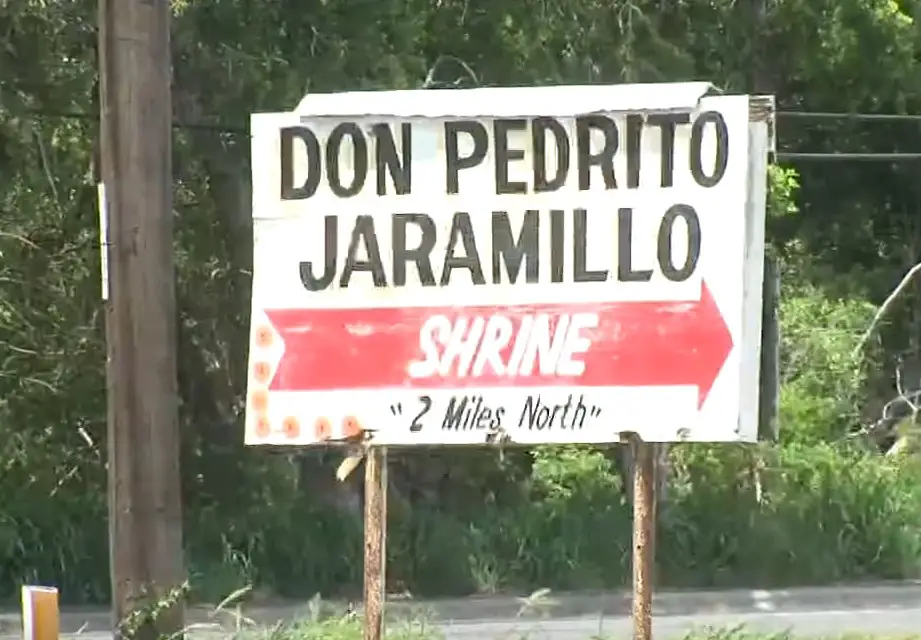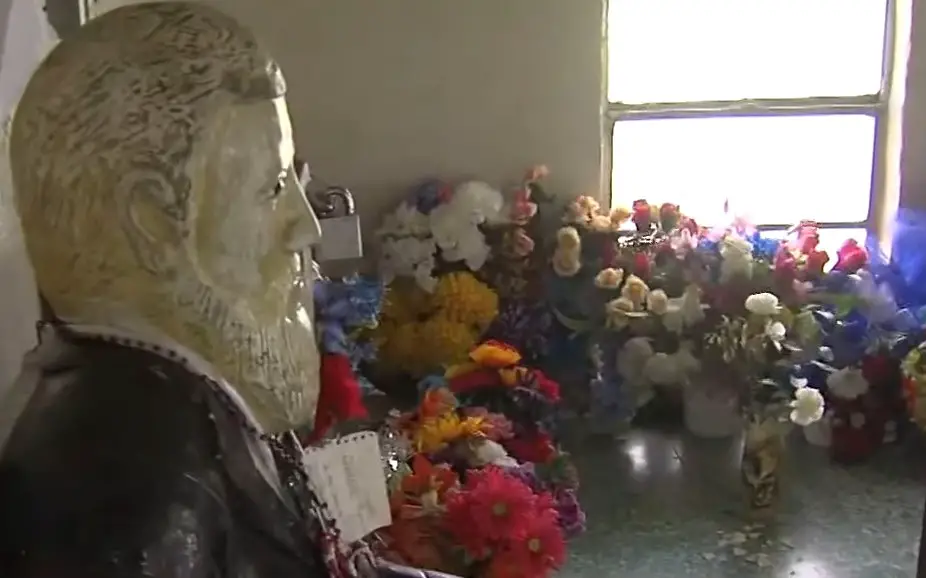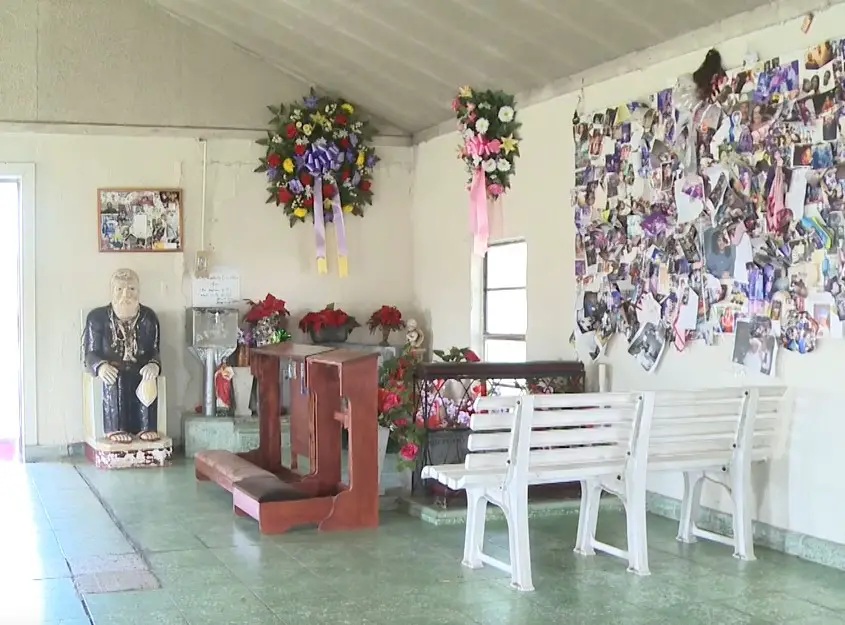Podcast: Play in new window | Download
Subscribe: Apple Podcasts | RSS
 About 70 miles north of Mexico’s border with the United States in the dusty Texas town of Falfurrias, there is a shrine to a very interesting man who spent half of his life there ministering to sick and troubled Mexicans and Mexican Americans. Sometimes referred to as a clairvoyant, a folk healer and even a magician, the man’s name was Pedro Jaramillo and is more affectionately known as Don Pedrito. The shrine, built near Don Pedrito’s grave, exists because even more than a century after the man’s death, devotees still believe that he has the power to cure or to just make things in life better.
About 70 miles north of Mexico’s border with the United States in the dusty Texas town of Falfurrias, there is a shrine to a very interesting man who spent half of his life there ministering to sick and troubled Mexicans and Mexican Americans. Sometimes referred to as a clairvoyant, a folk healer and even a magician, the man’s name was Pedro Jaramillo and is more affectionately known as Don Pedrito. The shrine, built near Don Pedrito’s grave, exists because even more than a century after the man’s death, devotees still believe that he has the power to cure or to just make things in life better.
Pedro Jaramillo was born near Guadalajara, Jalisco in 1829. His family were poor shepherds, and when he was a young man tending to sheep, Don Pedrito crashed into a tree branch while riding a horse. The blow knocked him unconscious, and he broke his nose, tearing the flesh down to the bone. When he regained consciousness, he had the urge to stick his face in the cool mud of a nearby creek for relief. He did this for three days. After those three days, although he was left with a visible scar on his nose for the rest of his life, Don Pedrito was completely healed and claimed that he heard the voice of God telling him that he would be a great healer. There is not much documentation on Don Pedrito’s early years as a curandero, or folk healer, in Mexico, but he must have spent a great deal of time honing his craft and learning from other natural and spiritual healers. There are volumes written on the folk medicine of the Mexican curandero who used herbs, barks, teas and mineral concoctions to cure the physically sick or to affect other positive changes in people or animals. This folk healing is a blend of Catholicism, indigenous herbal medicine and in some instances, modern-day spiritism. In Don Pedrito’s case, he emphasized the use of water in healings, and stressed over and over the need for faith in a higher power in the healing process. Perhaps because his nose took three days to heal, the number three was important in Don Pedrito’s prescriptions, as was the number nine. Although some of his remedies could be quite complex, some of his advice to patients and clients included drinking more water, eating more vegetables, and taking baths at designated times. While in Mexico, he worked many day labor jobs until he could live off donations from people who came to see him for his special gifts. Throughout his life, Pedro Jaramillo never charged for his consultations or treatments.
In 1881, Don Pedrito crossed over to the US and established himself in Brooks County, Texas, settling on the banks of the Los Olmos Creek, where he lived in a small adobe home and established a small rancho where he raised livestock and grew beans and corn. The land was donated to the curandero by a local man named Antonio Hinojosa Pérez. By the time he arrived in Texas, Don Pedrito’s reputation had already preceded him, and the locals welcomed such an esteemed individual. Oftentimes there would be a hundred or so people sitting in the shade of the creek-side trees  outside of Don Pedrito’s small hut, waiting to be seen. Visitors marveled at the curandero’s ability to know things about them that he couldn’t possibly have known, so in addition to being known as someone who could cure most anything, Don Pedrito was known as a kind of psychic. This inspired awe and sometimes fear in people. All the while, Pedro Jaramillo emphasized that it was not he who was doing any sort of healing or prognosticating, but that the power flowed from God through him. Although he never charged for his services, his patients and clients rewarded him with gifts of money or other tangible goods. Don Pedrito always shared the wealth and was often seen buying food for needy families or helping people out of bad financial situations. He often gave away the remedies he prescribed for free.
outside of Don Pedrito’s small hut, waiting to be seen. Visitors marveled at the curandero’s ability to know things about them that he couldn’t possibly have known, so in addition to being known as someone who could cure most anything, Don Pedrito was known as a kind of psychic. This inspired awe and sometimes fear in people. All the while, Pedro Jaramillo emphasized that it was not he who was doing any sort of healing or prognosticating, but that the power flowed from God through him. Although he never charged for his services, his patients and clients rewarded him with gifts of money or other tangible goods. Don Pedrito always shared the wealth and was often seen buying food for needy families or helping people out of bad financial situations. He often gave away the remedies he prescribed for free.
In October 1971, American author H.C. Arbuckle traveled to south Texas hoping to meet anyone who had known Don Pedrito. The author interviewed an 85-year old man named José Lozano who would visit the curandero with members of his family when he was a boy in the early years of the 20th Century. Here is the interview which gives a wonderful first-hand account of what Pedro Jaramillo was really like:
“Mi tío was the mail carrier from Los Olmos to Concepción and made the route daily. He rode a horse part of the time and walked part of the time, for it was sandy land and very hard on both horse and man to make the long, long trip. It is muy lejos from Los Olmos over to Concepción, very far, maybe even five or six miles.”
Buenos, pues, my uncle was such a drunkard that one day he was so borrachón con mescal y tequila that he fell off his horse and left the mail right there in the middle of the road, made it back to town on the horse, and finally came home to sleep it off. Mi tío knew that if he kept this up he would surely lose his job and he decided to see Don Pedrito for a remedio to cure him of his borracho.”
Entonces se va por Los Olmos, muy lejos, maybe even five or six miles away. The great man was at home and, when mi tío went to his house, hat in hand, to consult him, Don Pedrito greeted him with these words: ‘Hijo, you are the borracho that carries the mail from Los Olmost to Concepción and you want a remedio to cure you of this problem. Is this not why you have come?’”
My uncle fell to his knees, for how could Don Pedrito know this? Did he not live… at least five miles away? Surely, sin duda, Don Pedrito was anointed of God and a truly wise man, if not a mágico himself.”
 This then is what the wise Don Pedrito said: ‘Acerquita a su casa, hay una laguna’ (or in English, ‘Really close to your house is a lake’). My uncle thought, ‘How does Don Pedrito know of that little lake near my house? I live muy lejos, maybe even five or six miles away!’ The great man continued, ‘In the morning, take a bath in the lake; on the third day take another bath, and three days after that, another bath. With faith! Without faith, nothing will help you, but con fé, you will be cured.’”
This then is what the wise Don Pedrito said: ‘Acerquita a su casa, hay una laguna’ (or in English, ‘Really close to your house is a lake’). My uncle thought, ‘How does Don Pedrito know of that little lake near my house? I live muy lejos, maybe even five or six miles away!’ The great man continued, ‘In the morning, take a bath in the lake; on the third day take another bath, and three days after that, another bath. With faith! Without faith, nothing will help you, but con fé, you will be cured.’”
The very next morning, mi tío took the first bath, clothes and all, in the laguna; the third morning after that, he took the second bath; and the final third morning, the third bath. All this he did con fé, (with faith), knowing that he would be cured.”
And as sure as I am sitting right here and now in my house, mi tío never to his dying day after that took anything stronger than coffee or tea. He never touched a drop of any pulque, mescal, tequila, wine or even beer. I know this to be a fact, for I was there, and I know what I know. And I know that it was the faith, in Don Pedrito, in El Señor Dios, and in their combined powers, that cured my uncle.”
End of interview.
In 1894, by popular demand, Pedro Jaramillo made a medical mission trip to San Antonio. It was then when he began to show up on the radar of the professional medical establishment. The American doctors in San Antonio labeled the Mexican healer a dangerous quack, perhaps out of jealousy of Don Pedrito’s popularity and his track record of providing miracle cures. Seven years after this visit to San Antonio, the American Medical Association and the US Postal Service sued Jaramillo in federal court claiming he was offering fake cures and was using the US Mail to commit fraud. The case was dropped because his lawyer, a famous south Texas politician and attorney named José Tomás Canales, argued that Don Pedrito never charged for his cures and treatments. Canales was a big fan because the curandero healed his sick mother a few years before when modern medicine had failed her.
Don Pedrito Jaramillo died on July 3, 1907 at the age of 88. He had never married but he had adopted two sons soon after arriving in the States. When they cleaned out the famous curandero’s modest adobe hut after he died, they found a hoard of over 10,000 silver fifty-cent pieces along with thousands of letters from people asking for help or sending their sincere thanks for healings performed.
 The shrine that exists on Jaramillo’s property is maintained by the descendants of his neighbors who keep his memory alive. This pilgrimage site attracts people from both sides of the border. Since his death, Don Pedrito has grown into a folk saint in his own right with people leaving petitions in the form of written letters accompanied by candles and other offerings, hoping for healings, family harmony or assistance with financial matters. The devotion to this Mexican icon has increased over the years and so have the mystery and powers ascribed to him. Legends and stories have emerged since his death that defy belief and are impossible to verify and add to the curandero’s mythos. His memory has even succumbed to 21st Century “wokeness” and cultural revisionism. On Don Pedrito’s Wikipedia page and in subsequent blogs that repeat and copy things endlessly, the folk healer is described as having indigenous parents from the Tarascan or Purépecha tribe, even going so far as to cite a source that does not even contain this information. One look at Don Pedrito’s photos where he is sporting a long, white, Santa Claus beard dispel these bad attempts at cultural revisionism. No native Tarascan looks like this and the Purépecha territory was nowhere near Guadalajara where Don Pedrito’s family was from. Given more time as a folk saint, Don Pedrito’s devotion will most likely grow and may change into something else entirely. Such is the nature of grassroots belief and our mortal intersection with the supernatural and divine.
The shrine that exists on Jaramillo’s property is maintained by the descendants of his neighbors who keep his memory alive. This pilgrimage site attracts people from both sides of the border. Since his death, Don Pedrito has grown into a folk saint in his own right with people leaving petitions in the form of written letters accompanied by candles and other offerings, hoping for healings, family harmony or assistance with financial matters. The devotion to this Mexican icon has increased over the years and so have the mystery and powers ascribed to him. Legends and stories have emerged since his death that defy belief and are impossible to verify and add to the curandero’s mythos. His memory has even succumbed to 21st Century “wokeness” and cultural revisionism. On Don Pedrito’s Wikipedia page and in subsequent blogs that repeat and copy things endlessly, the folk healer is described as having indigenous parents from the Tarascan or Purépecha tribe, even going so far as to cite a source that does not even contain this information. One look at Don Pedrito’s photos where he is sporting a long, white, Santa Claus beard dispel these bad attempts at cultural revisionism. No native Tarascan looks like this and the Purépecha territory was nowhere near Guadalajara where Don Pedrito’s family was from. Given more time as a folk saint, Don Pedrito’s devotion will most likely grow and may change into something else entirely. Such is the nature of grassroots belief and our mortal intersection with the supernatural and divine.
REFERENCES
Arbuckle, H. C. “Don José and Don Pedrito.” Southwest Review, vol. 59, no. 2, 1974, pp. 189–94
Ferguson, Wes. “How Curandero Don Pedro Jaramillo Became a South Texas Folk Saint.” In Texas Highways, 27 August 2020.
Griffith, James. Folk Saints of the Borderlands. Tucson: Rio Nuevo Publishers, 2003. We are Amazon affiliates. Get the book on Amazon here: https://amzn.to/3D3NXKT
